
The Enchanting Wilderness of Bieszczady Mountains
Discover the serene beauty and rich wildlife of Poland's Bieszczady Mountains, a hidden gem offering unparalleled hiking trails and cultural experiences.
Nestled in the southeastern corner of Poland, the Bieszczady Mountains offer an unspoiled retreat for nature lovers and adventure seekers alike. These mountains form part of the Eastern Carpathians and are known for their rolling hills, lush forests, and serene valleys. Far removed from the hustle and bustle of city life, the Bieszczady Mountains provide a tranquil escape where visitors can connect with nature on a profound level. The region is a haven for wildlife enthusiasts. It is home to an array of species including lynx, wolves, and European bison. Bird watchers will be delighted to spot rare birds such as the golden eagle and the Ural owl. Hiking trails crisscross the landscape, leading to breathtaking viewpoints and hidden waterfalls. The Połoniny, or mountain meadows, are especially captivating, offering panoramic vistas of the surrounding peaks and valleys. Cultural experiences are also abundant in the Bieszczady Mountains. Scattered across the region are charming villages where time seems to stand still. Wooden Orthodox churches, some of which are UNESCO World Heritage Sites, add a historical dimension to the journey. Local artisans sell handmade crafts that reflect the rich traditions of the area. Whether you are exploring the natural beauty or delving into the local culture, the Bieszczady Mountains promise a memorable and enriching experience.
Local tips in Bieszczady Mountains
- Visit in late spring or early autumn for the best weather and fewer crowds.
- Pack sturdy hiking boots as trails can be rugged and muddy.
- Carry a local map; cell service can be unreliable in remote areas.
- Try local delicacies such as pierogi and oscypek cheese in village eateries.
- Respect wildlife and maintain a safe distance from animals.
- Check opening hours of Orthodox churches as they may vary.
The Enchanting Wilderness of Bieszczady Mountains
Nestled in the southeastern corner of Poland, the Bieszczady Mountains offer an unspoiled retreat for nature lovers and adventure seekers alike. These mountains form part of the Eastern Carpathians and are known for their rolling hills, lush forests, and serene valleys. Far removed from the hustle and bustle of city life, the Bieszczady Mountains provide a tranquil escape where visitors can connect with nature on a profound level. The region is a haven for wildlife enthusiasts. It is home to an array of species including lynx, wolves, and European bison. Bird watchers will be delighted to spot rare birds such as the golden eagle and the Ural owl. Hiking trails crisscross the landscape, leading to breathtaking viewpoints and hidden waterfalls. The Połoniny, or mountain meadows, are especially captivating, offering panoramic vistas of the surrounding peaks and valleys. Cultural experiences are also abundant in the Bieszczady Mountains. Scattered across the region are charming villages where time seems to stand still. Wooden Orthodox churches, some of which are UNESCO World Heritage Sites, add a historical dimension to the journey. Local artisans sell handmade crafts that reflect the rich traditions of the area. Whether you are exploring the natural beauty or delving into the local culture, the Bieszczady Mountains promise a memorable and enriching experience.
When is the best time to go to Bieszczady Mountains?
Iconic landmarks you can’t miss
Bieszczady National Park
Explore Bieszczady National Park: A stunning natural paradise filled with breathtaking landscapes, diverse wildlife, and serene hiking trails in Poland.

Reserve Sine Wiry
Explore the enchanting landscapes of Reserve Sine Wiry, a nature preserve in Poland, ideal for nature lovers and adventure seekers alike.

Szepit waterfall on a creek Hylaty
Experience the breathtaking beauty of Szepit Waterfall in Zatwarnica, a serene hiking destination in Poland's stunning Podkarpackie region.

Połonina Wetlińska
Experience breathtaking views and serene landscapes at Połonina Wetlińska, a stunning alpine meadow in the heart of Bieszczady Mountains, Poland.

Studenne - punkt widokowy
Discover the breathtaking vistas at Studenne, a scenic observation deck in the heart of the Bieszczady Mountains, perfect for hiking and nature lovers.

Unmissable attractions to see
Zapora w Solinie
Experience the breathtaking views and recreational adventures at the stunning Zapora w Solinie, a top tourist attraction in Poland's Bieszczady Mountains.

Bieszczady National Park
Explore the breathtaking landscapes of Bieszczady National Park, a hidden gem ideal for hiking, wildlife watching, and embracing nature's tranquility.

Bieszczady Forest Railway
Experience the enchanting Bieszczady Forest Railway, a scenic steam train journey through Poland's breathtaking landscapes and rich history.

Zagroda Pokazowa Żubrów
Explore the enchanting world of European Bison at Zagroda Pokazowa Żubrów, a must-see attraction for nature lovers in Poland.

Reserve Sine Wiry
Explore the untouched beauty of Reserve Sine Wiry, a serene nature preserve in Poland, where stunning landscapes and diverse wildlife await.

Wodospad Ostrowskich
Explore the breathtaking beauty of Wodospad Ostrowskich in Wetlina, a must-see natural attraction in the heart of Podkarpackie.

Lesko Stone
Explore the breathtaking Lesko Stone, a captivating natural landmark in the Bieszczady Mountains, perfect for adventure and tranquility.
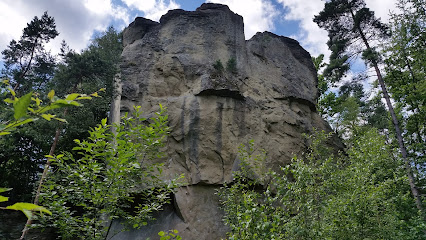
Szepit waterfall on a creek Hylaty
Experience the breathtaking Szepit Waterfall in Zatwarnica, a picturesque hiking area that captivates with its natural beauty and serene landscapes.

Cottage On The Roof
Discover tranquility and rustic charm at Cottage On The Roof, a picturesque retreat in Uherce Mineralne, perfect for nature lovers and explorers.

Natural History Museum of the Bieszczady National Park
Discover the diverse ecosystems and rich wildlife of the Bieszczady National Park at its captivating Natural History Museum.

Osadzki Wierch
Explore the breathtaking Osadzki Wierch in Cisna, where nature's beauty meets adventure in the heart of the Bieszczady Mountains.

Połonina Wetlińska
Experience the breathtaking beauty of Połonina Wetlińska, a natural gem in Poland's Bieszczady Mountains, perfect for hiking and nature exploration.

Ruiny cerkwi
Discover the enchanting ruins of the church in Berezka, a serene tourist attraction steeped in history and surrounded by breathtaking landscapes.

Ścieżka przyrodnicza Otaczarnia Terka
Explore the breathtaking beauty of Otaczarnia Terka, a scenic hiking area and observation deck nestled in the stunning Bieszczady Mountains of Poland.
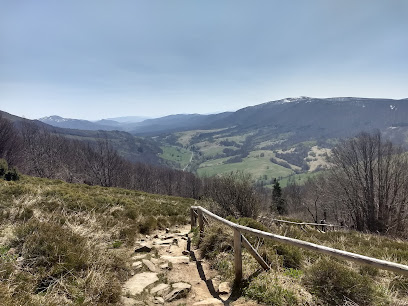
Dwernik Kamień 1004 m n.p.m.
Explore the breathtaking Dwernik Kamień peak in the Bieszczady Mountains, where stunning views and nature's beauty await every adventurer.

Essential places to dine
Paweł Nie Całkiem Święty
Experience authentic Polish cuisine at Paweł Nie Całkiem Święty - where tradition meets flavor in beautiful Wetlina.

Oberża ZAKAPIOR
Discover the heart of Polish cuisine at Oberża ZAKAPIOR in Polańczyk - where tradition meets flavor in every dish.
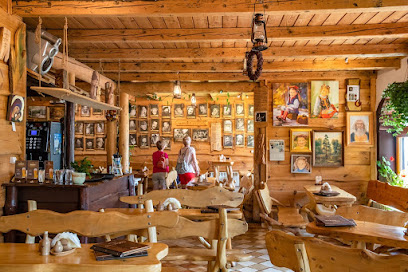
Karczma Brzeziniak
Experience authentic Polish cuisine at Karczma Brzeziniak, a charming restaurant and bed & breakfast nestled in scenic Przysłup.

Oberża Biesisko
Discover Oberża Biesisko: A charming family-friendly restaurant in Przysłup serving authentic Polish dishes amidst stunning natural beauty.

Bar under the shingles
Discover authentic Polish cuisine at Bar Under the Shingles in Bukowiec—where tradition meets flavor in every dish.

Wilczy Kęs
Experience delicious Polish cuisine in Krzywe at Wilczy Kęs—perfect for families and vegetarians seeking flavorful dishes.

Góra Smaku
Discover Góra Smaku: A delightful vegetarian café in Przysłup offering delicious plant-based dishes and cozy dining experiences.

RAJSKA CHATA
Experience authentic Polish cuisine in a warm family-friendly atmosphere at Rajska Chata, your culinary haven in Rajskie.

Markets, malls and hidden boutiques
Biedronka
Explore Biedronka in Lesko for an authentic shopping experience filled with local flavors, fresh produce, and affordable prices.

Bieszczady Mountains
Explore the breathtaking beauty of the Bieszczady Mountains, a hidden gem in Poland perfect for outdoor adventures and cultural experiences.

Sklep u Zdzicha
Explore the local flavors and community spirit at Sklep u Zdzicha, the charming grocery store in the heart of Wetlina, Poland.
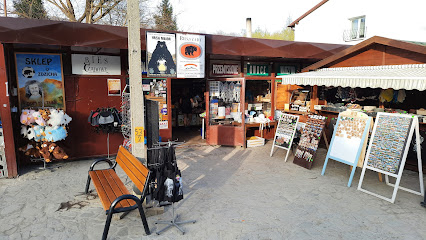
Menelux
Discover Menelux, a charming grocery store in Zawóz, offering fresh produce and local delights for every traveler’s needs.

SUPERMARKET
Discover local flavors and essentials at Solina's inviting grocery store, your gateway to the region's culinary delights and convenience.

Sklep ABC
Discover quality groceries, local products, and more at Sklep ABC, Wetlina's charming store for all your essentials.

Trzynastka - sklep / bar z alkoholem i kawą / księgarnia / sklep z alkoholem
Discover Trzynastka in Wetlina: a cozy lounge that combines literature with a fine selection of coffee and alcoholic beverages.

Sklep Spożywczy
Discover local flavors and essentials at Sklep Spożywczy in Terka, your go-to grocery and beer shop for an authentic Polish experience.

Sklep Centrum - Nasz Sklep
Discover the essence of Polish cuisine at Sklep Centrum - Nasz Sklep, your go-to grocery store in Ustrzyki Górne for local delicacies and fresh produce.

Angling Shop Polańczyk - Solina
Explore the ultimate fishing experience at Angling Shop Polańczyk - Solina, your go-to destination for gear and local fishing insights in the Bieszczady region.

Galeria - Kawiarnia DZIKA SZYSZKA
Experience the perfect fusion of artisanal coffee and local handicrafts at Galeria - Kawiarnia DZIKA SZYSZKA in Wetlina.
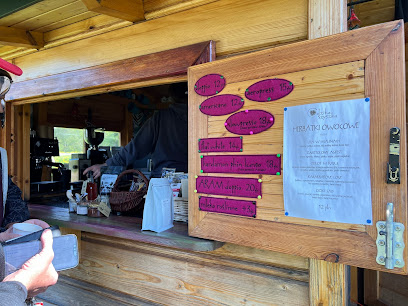
Mini Market
Explore local flavors and everyday essentials at Mini Market, the charming grocery store in Lutowiska, Poland.

4F sklep sportowy - F.H. DAR-STYL
Explore the best outdoor gear at 4F Sklep Sportowy - F.H. DAR-STYL in Ustrzyki Dolne, your one-stop destination for sporting goods and expert advice.

Martes Sport
Explore Martes Sport in Ustrzyki Dolne for high-quality sporting goods, expert advice, and all your athletic needs to conquer the Polish outdoors.

Galeria Powidok i Bieszczadzka Pracownia Ikon
Discover the beauty of traditional icon artistry at Galeria Powidok in the heart of Smerek, Poland, where craftsmanship meets culture.

Essential bars & hidden hideouts
Baza ludzi z mgły
Discover the charming Baza ludzi z mgły in Wetlina – a cozy bar offering local drinks and stunning mountain views.

Bar under the shingles
Discover the flavors of Poland at Bar Under the Shingles, a cozy eatery in Bukowiec perfect for food lovers seeking authentic experiences.

Wilczy Kęs
Experience the delightful flavors of Polish cuisine at Wilczy Kęs, a family-friendly restaurant in Krzywe with vegetarian options and a vibrant atmosphere.

Bar Bolek
Discover the flavors of Poland at Bar Bolek, a cozy restaurant and lounge in Solina, perfect for unwinding after a day of adventure.

Zagroda Żbyr
Discover the charm of Zagroda Żbyr, a cozy bar in Werlas offering local flavors and a welcoming atmosphere for every traveler.

Bar Na Stawach
Experience the warmth and charm of Bar Na Stawach in Krzywe, a cozy bar offering a delightful selection of drinks in a stunning natural setting.

Banderoza
Experience the warmth of Polish hospitality at Banderoza, a cozy lounge and bar in Liszna, perfect for relaxation and social gatherings.

Czarne Złoto PUB i kręgielnia
Discover Czarne Złoto PUB i Kręgielnia in Polańczyk for delicious pizza and fun bowling in a vibrant atmosphere.

Ranczo - Wetlina Wschodnia
Discover the charm of Ranczo - Wetlina Wschodnia, a cozy bar in the heart of the Bieszczady Mountains, perfect for unwinding with a drink amidst stunning scenery.
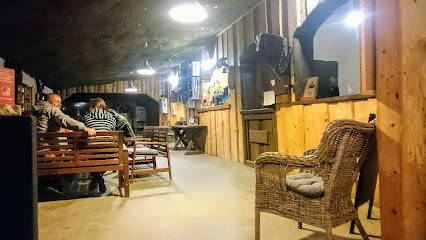
Bolo Bar
Discover the unique flavors of Poland at Bolo Bar, where exquisite dining meets a relaxed lounge atmosphere in the heart of Zawóz.

Moto Zone Bieszczady
Discover the flavors of Moto Zone Bieszczady, where gourmet grilling meets the breathtaking beauty of the Bieszczady Mountains.

Bar nad Stawem KRYWY POTOK
Discover the flavors of Poland at Bar nad Stawem KRYWY POTOK, a charming grill bar offering delicious dishes in a serene natural setting.

Bar przy domkach - u Jadzi
Discover the charm of Bar przy domkach - u Jadzi in Olchowiec, where local flavors and beautiful surroundings create a perfect getaway.

Bar Foka
Discover local flavors and warm Polish hospitality at Bar Foka, a charming bar in the heart of Zawóz, perfect for unwinding after a day of exploration.

Berezka 39
Discover the charm of Berezka 39, a cozy bar in Polańczyk offering a perfect blend of local beverages and welcoming atmosphere.

Local Phrases about Bieszczady Mountains
-
- HelloCześć
[Cheshch] - GoodbyeDo widzenia
[Do veedzenia] - YesTak
[Tak] - NoNie
[Nyeh] - Please/You're welcomeProszę
[Prosheh] - Thank youDziękuję
[Jenkoo-yeh] - Excuse me/SorryPrzepraszam
[Pzheh-prasham] - How are you?Jak się masz?
[Yak shieh mash] - Fine. And you?Dobrze. A Ty?
[Dobzheh. A Ti] - Do you speak English?Czy mówisz po angielsku?
[Chy moovish po ang-yelskoo] - I don't understandNie rozumiem
[Nyeh rozoom-yem]
- HelloCześć
-
- I'd like to see the menu, pleaseMógłbym zobaczyć menu, proszę
[Moogwim zobachich menu, prosheh] - I don't eat meatNie jem mięsa
[Nyeh yem myensa] - Cheers!Na zdrowie!
[Na zdrov-yeh] - I would like to pay, pleasePoproszę o rachunek
[Poprosheh o rah-hoonek]
- I'd like to see the menu, pleaseMógłbym zobaczyć menu, proszę
-
- Help!Pomoc!
[Pomots] - Go away!Idź sobie!
[Eedzh sobyeh] - Call the Police!Zadzwoń po policję!
[Zadzvon po politsyeh] - Call a doctor!Zadzwoń po lekarza!
[Zadzvon po lek-arza] - I'm lostZgubiłem się
[Zgoobee-wem shieh] - I'm illJestem chory
[Yestem hory]
- Help!Pomoc!
-
- I'd like to buy...Chciałbym kupić...
[Hchalbim koopeech] - I'm just lookingTylko się rozglądam
[Tzylko shieh rozh-gwam] - How much is it?Ile to kosztuje?
[Eeleh to kosh-too-yeh] - That's too expensiveTo jest za drogie
[To yest za drog-yeh] - Can you lower the price?Czy możesz obniżyć cenę?
[Chy mooshesh oobnee-zhich chenoo]
- I'd like to buy...Chciałbym kupić...
-
- What time is it?Która jest godzina?
[Ktura yest god-zina] - It's one o'clockJest pierwsza
[Yest pyerv-sha] - Half past (10)Jest wpół do jedenastej
[Yest vwul do yedenast-eh] - MorningRano
[Rano] - AfternoonPopołudnie
[Popowood-nyeh] - EveningWieczór
[Vie-choor] - YesterdayWczoraj
[Vcho-rye] - TodayDzisiaj
[Jee-sheye] - TomorrowJutro
[Yootro] - 1Jeden
[Yeden] - 2Dwa
[Dva] - 3Trzy
[Tshi] - 4Cztery
[Chteri] - 5Pięć
[Pyench] - 6Sześć
[Sheshch] - 7Siedem
[Shedem] - 8Osiem
[Oshyem] - 9Dziewięć
[Jevnyehch] - 10Dziesięć
[Jeshehch]
- What time is it?Która jest godzina?
-
- Where's a/the...?Gdzie jest...
[Gdzyeh yest] - What's the address?Jaki jest adres?
[Yaki yest adresh] - Can you show me (on the map)?Czy możesz mi pokazać (na mapie)?
[Chy mooshesh mi pokazach (na map-yeh)] - When's the next (bus)?Kiedy jest następny (autobus)?
[Kiedy yest nastepny (autobus)] - A ticket (to ....)Bilet (do ...)
[Bileht (do)]
- Where's a/the...?Gdzie jest...
History of Bieszczady Mountains
-
The Bieszczady Mountains, part of the Carpathian Mountain range, have been inhabited since the early Stone Age. Archaeological findings suggest that the region was home to ancient tribes who practiced agriculture and animal husbandry. By the medieval period, the area became a melting pot of various cultures, including the Slavs, Vlachs, and Ruthenians, who left their mark on the region through their customs, dialects, and architectural styles.
-
In the late 18th century, the Bieszczady Mountains became part of the Habsburg Monarchy's Kingdom of Galicia and Lodomeria following the first partition of Poland in 1772. This period saw significant administrative, social, and economic transformations. The Habsburgs introduced modern infrastructure, such as railways and roads, which connected the remote mountainous area to larger urban centers.
-
World War II had a devastating impact on the Bieszczady region, resulting in significant population displacement and destruction. The area was occupied by both Nazi Germany and the Soviet Union at different times. After the war, the borders were redrawn, and the Bieszczady Mountains became part of the People's Republic of Poland. The region witnessed forced resettlements, particularly of the local Ukrainian and Lemko populations, as part of the Operation Vistula in 1947.
-
Operation Vistula (Akcja Wisła) was a significant event in the history of the Bieszczady Mountains. In 1947, the Polish government forcibly relocated over 140,000 Ukrainians and Lemkos from southeastern Poland, including the Bieszczady region, to the Recovered Territories in the west. This operation aimed to eliminate support for the Ukrainian Insurgent Army (UPA) but resulted in the depopulation and cultural transformation of the Bieszczady area.
-
After the tumultuous war years and population shifts, the Bieszczady Mountains experienced a period of rejuvenation. The 1960s and 1970s saw the development of tourism infrastructure, attracting nature enthusiasts, hikers, and artists. The establishment of the Bieszczady National Park in 1973 played a crucial role in preserving the region's biodiversity and promoting sustainable tourism. This era marked the beginning of the Bieszczady Mountains' transformation into a beloved travel destination.
-
The Bieszczady Mountains are rich in cultural heritage and folklore, deeply influenced by the various ethnic groups that have inhabited the region. Traditional wooden churches, known as 'cerkiew,' dot the landscape, showcasing the unique architectural styles of the Lemko and Boyko cultures. Local folklore is celebrated through music, dance, and festivals, preserving the oral traditions and legends passed down through generations. The region's artisanal crafts, such as wood carving and weaving, also reflect its diverse cultural mosaic.
Bieszczady Mountains Essentials
-
The Bieszczady Mountains are located in southeastern Poland, in the Subcarpathian Voivodeship. The nearest major city with an airport is Rzeszów, which is approximately 150 kilometers away. From Rzeszów, you can rent a car or take a train or bus to Sanok, Ustrzyki Dolne or Cisna, which are popular starting points for exploring the Bieszczady region. Alternatively, you can take a direct bus from major Polish cities such as Kraków and Warsaw to these towns.
-
Public transportation in the Bieszczady Mountains is limited but available. Buses and minibuses (often referred to as 'busik') connect key towns and villages. However, for maximum flexibility, renting a car is highly recommended. Local taxis are also available but might be less convenient for exploring remote areas. During the summer, some tourist trains operate in the region, offering scenic routes through the mountains.
-
The official currency in Poland is the Polish Zloty (PLN). Credit cards are widely accepted in larger towns and tourist areas, but it's advisable to carry cash, especially when venturing into more remote areas of the Bieszczady Mountains. ATMs are available in larger towns like Sanok and Ustrzyki Dolne, but make sure to withdraw enough cash before heading into rural areas.
-
The Bieszczady Mountains are generally safe for tourists. However, standard precautions should be taken. Avoid leaving valuables in plain sight and be cautious when hiking in remote areas, as mobile phone coverage can be spotty. There are no specific high-crime areas targeting tourists, but it's always best to stay vigilant and aware of your surroundings.
-
In case of emergency, dial 112 for immediate assistance. This number works for police, fire, and medical emergencies. It's advisable to have travel insurance that covers medical emergencies. There are medical facilities in larger towns such as Sanok and Ustrzyki Dolne. For minor health issues, pharmacies are available in these towns where you can purchase over-the-counter medications.
-
Fashion: Do dress modestly and wear appropriate hiking gear when exploring the mountains. Avoid wearing flashy or revealing clothing. Religion: Do respect local customs and traditions, especially when visiting religious sites. Public Transport: Do be respectful and give up your seat to elderly passengers. Don’t eat or drink on public transport. Greetings: Do greet people with a handshake. A friendly 'Dzień dobry' (Good day) goes a long way. Eating & Drinking: Do try local delicacies and accept food offerings graciously. Don’t refuse hospitality, as it is considered impolite.
-
To experience the Bieszczady Mountains like a local, visit local markets to buy fresh produce and traditional Polish goods. Engage with locals, who are often friendly and willing to share stories about the region’s history and culture. Don’t miss hiking trails such as Połonina Wetlińska and Połonina Caryńska, which offer breathtaking views. For a unique experience, take a ride on the Bieszczady Forest Railway, a narrow-gauge railway offering scenic tours through the mountains.
Nearby Cities to Bieszczady Mountains
-
Things To Do in Rzeszow
-
Things To Do in Mukachevo
-
Things To Do in Prešov
-
Things To Do in Košice
-
Things To Do in Lviv
-
Things To Do in Tarnow
-
Things To Do in Nyiregyhaza
-
Things To Do in Poprad
-
Things To Do in Ivano-Frankivsk
-
Things To Do in Satu Mare
-
Things To Do in Miskolc
-
Things To Do in Zakopane
-
Things To Do in Baia Mare
-
Things To Do in Krakow
-
Things To Do in Debrecen












